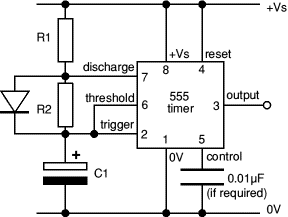Pulse Width Modulation (PWM) is the technique of using the duty cycle (see above) of a
digital (on/off) signal to control an analogue quantity such as the brightness of an LED or the speed of a motor.
For example an LED will be bright if the duty cycle is 90% (mostly on), but dim if the duty cycle is 10% (mostly off).
The pulse frequency must be sufficiently high for the output to appear continuous, for example 1kHz (1000 flashes per second)
which is too fast for our eyes to see the rapid flashes, instead we see an average brightness determined by the duty cycle.
The circuit diagram shows how 2 diodes and a variable resistor can be used with a 555 timer to make a PWM circuit for
varying the brightness of an LED.
The diodes ensure that one part of the variable resistor track (plus 1kΩ)
is used for the mark time (Tm) while the other part is used for the space time (Ts).
This arrangement ensures that the total time period, Tm + Ts, (and frequency) is almost constant while
the duty cycle is varied. The 1kΩ resistor ensures that R1 is
never less than 1kΩ to protect the 555 timer.
With the values shown the frequency is about 1kHz, this is ideal for varying the brightness of an LED.
Use three PWM circuits like this to independently vary the brightness of the red, green and blue LEDs inside an
RGB LED to produce a wide range of colours.








